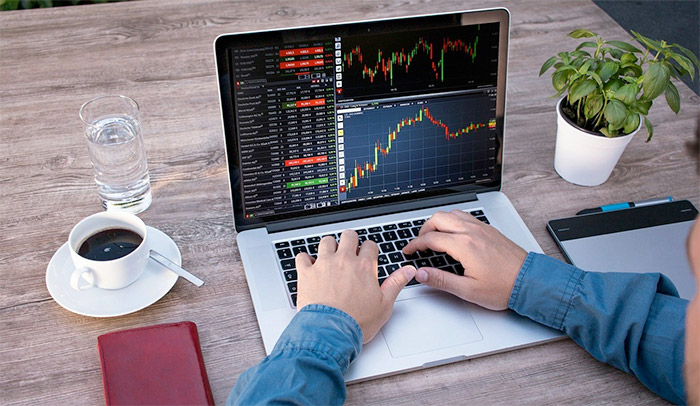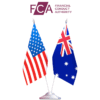Content Guide

Forex trading is an extremely popular activity, favoured by traders and investors worldwide, and it’s not hard to figure out the reasons why. Featuring a dynamic environment, forex, also known as FX or foreign exchange, offers access to the global markets 24 hours a day, five days a week.
In this beginner’s guide, we’ll be taking you through the forex trading basics, including what the forex market is, who trades it, and how you can get started on your trading journey. Whether you are a beginner or a novice trader, there are some golden nuggets of information you may find useful.
What is the Forex Market?
The forex market is essentially a global marketplace where individuals and institutions can buy, sell, and trade currencies. It’s widely regarded as the largest and most liquid financial market in the world, with many trillions of dollars being traded each day. Its participants include banks, corporations, governments, and individual traders.
Unlike stock exchanges, FX trading doesn’t have a definitive, centralised location. That’s because it functions electronically over-the counter (OTC) via a network of different financial institutions. Major hubs including London, New York, Tokyo, and Sydney operate continuously, ensuring that the forex market is active round-the-clock across the different time zones.
How Does Forex Work?
On a practical level, forex trading involves the buying of one currency and selling of another, conducted via currency pairs such as EUR/USD and GBP/JPY. Prices are influenced by a range of factors, including economic news, geopolitical events, and market sentiment. Traders can try to predict currency price movements using various analytical tools like charts, technical indicators, and market news. Forex can be traded on margin, which means traders only need to deposit a small amount of the total trade value.
Who Trades Forex?
Since currency trading has shifted online, FX trading has become more accessible to a much broader range of participants. Whether it’s from a financial institution or an individual investor, trading on the forex market can take place for different reasons. For example, banks, hedge funds, and multinational corporations trade forex to hedge risk or profit from currency movements. Meanwhile, individual traders are often drawn to the market for its high liquidity and attracted by the potential to earn profits by speculating on price fluctuations.
What is Forex Trading?
Fundamentally, forex trading is all about making money by exchanging one currency for another in order to benefit from changes in the exchange rate. Take the EUR/USD pair, for example: if you think the euro will strengthen against the US dollar, you’ll choose to buy euros with dollars. As the euro rate goes up, you can sell it for more dollars, earning yourself a profit.
Aside from speculation, forex trading also serves as a way to protect against losses from changes in currency values, helping individuals and businesses keep their costs stable. Because forex is a global market, currencies are influenced by factors like interest rates, inflation, and geopolitical events. A country’s economy and political stability can also affect its currency, making forex trading a reflection of global economic and political trends.
How to Start Trading Forex
Before you get started on your forex trading journey, you should take things step-by-step to make sure you are ready and prepared for what’s next. First, it’s really important that you understand the basics of how the forex markets operate and how currency prices are influenced. Once you’re confident with your trading knowledge, the next step is to find a trusted and reliable forex broker to open a trading account with, preferably one offering a platform that best matches your trading style. After completing the registration process with your chosen FX brokerage, you’ll be able to fund your account and explore the platform’s full range of features. Lastly, just before you trade the live markets, most brokers allow you to practise your trading strategies in a risk-free environment via a demo account.
How to Profit from Trading Forex
To make a success of trading forex, traders need to have the right combination of knowledge, strategy, and discipline. A popular approach employed by traders is the use of technical analysis, which involves examining price charts and trends in order to anticipate future movements. Another common method is fundamental analysis, where the focus is on economic data releases, global events, and central bank policy decisions typically found by checking news and a reliable Economic Calendar.
Risk management plays a crucial role in a trader’s success, with tools such as stop-loss orders being key to reducing potential losses. Profitable traders manage to strike a balance between the factors mentioned above, often maintaining a long-term outlook. However, they also understand that short-term profits are possible, while remaining aware of the inherent volatility within global markets.
Basic Forex Trading Strategies
To successfully navigate the forex market, traders use a variety of strategies, each suited to different timeframes and styles. The two most basic trading strategies involve long and short positions, where price movements are tracked in pips, points, and ticks. In a long position, a trader typically expects that the currency’s value will rise, with the intention of selling at a higher price, while a short position involves predicting that the currency’s price will fall.
Whether you’re drawn to short-term trades or prefer holding positions over a longer period of time, knowing these strategies can help you in making well-informed decisions. Below are some of the most common forex trading strategies used by both beginners and experienced traders.
Day Trading
Day trading involves the buying and selling of currencies within the same trading day, with no positions being held overnight. It relies on short-term price fluctuations and requires quick decision-making. This strategy is best suited for traders who can dedicate time to closely monitor the markets throughout the day.
Swing Trading
Swing trading is where positions are held for several days or even weeks in order to capitalise on medium-term price movements. The aim here is to profit from market ‘swings’ by identifying entry and exit points based on technical analysis. This strategy requires less time commitment than day trading, making it popular among part-time traders.
Position Trading
Position trading is focused more on long-term market trends, where trades are held over the course of many weeks, months, or even years. This strategy is more reliant on fundamental analysis, including economic and political factors that have an impact on currency values. Position traders are less concerned about short-term market fluctuations and are more willing to wait for significant, long-term gains.
Scalp Trading
Scalp trading involves the execution of several small trades across the same day, with each trade only lasting a few minutes. The intended goal here is to accumulate frequent profits through taking advantage of minor price movements. It is a strategy that requires a high level of focus and is best suited for traders who enjoy fast-paced trading environments.
Key Forex Terminology
Having a good understanding of key forex terms is an important part of any trader’s knowledge base. By keeping informed and familiarising yourself with the basic terminology, you’ll be in a better position to interpret market data, giving you greater confidence when trading the global markets. Listed below are some of the most common terms you’ll come across in forex trading and you can also check our Trading Glossary for many more useful terms.
Forex Account
Forex accounts allow traders to hold, buy, or sell foreign currencies. They can be opened with a forex broker and represent the first step for traders beginning their trading journeys. Various account types offer different leverage, margin requirements, and trading conditions.
Bid
The bid price is the price at which a trader can sell a currency pair. It’s always lower than the ask price, representing the maximum price a buyer is willing to pay for a currency. The difference between the bid and ask prices is how brokers make a profit from trades.
Ask
The ask price refers to the lowest amount a seller is willing to accept for a currency pair. It’s always higher than the bid price and helps define the spread, which is the difference between the buying and selling prices in the forex market.
Contract for Difference
A Contract for Difference (CFD) is an agreement between a buyer (investor) and a seller (CFD broker) to exchange the difference in an asset’s value from when the contract is opened to when it is closed. As a derivative product, CFDs allow traders to speculate on the price movements of assets, such as forex pairs, without owning the underlying asset.
Leverage
Leverage allows traders to control positions of greater value than their initial deposit by effectively ‘borrowing’ funds from the broker, with the goal of enhancing their potential returns. On the other hand, leverage can also magnify losses, so it’s important to use it wisely. For more details, check out our in-depth article on leverage.
Live Forex Charts
The live forex charts offer a crucial go-to resource for traders, providing real-time price movements of currency pairs. They also display historical and current price data, helping traders to identify trends and pinpoint potential entry or exit points. Most major trading platforms offer a variety of charting options, including line, bar, and candlestick charts, alongside technical indicators like moving averages and oscillators. By keeping track of the live FX charts, traders can make better informed decisions more quickly, which is important when trading in such a dynamic and fast-moving environment.
Which Currencies Can I Trade In?
With forex trading, you can trade a wide range of currency pairs from all corners of the globe. The most popular trades made in the forex market tend to involve the US dollar (USD), with major currency pairs such as EUR/USD, GBP/USD, and USD/JPY being commonly traded.
You can also trade minor and exotic pairs, which don’t include the USD, but instead feature either one (minor) or two (exotic) currencies from smaller or emerging economies. The Australian dollar (AUD) and Canadian dollar (CAD) are classed as minor currencies, while the South African rand (ZAR) and Thai baht (THB) are referred to as exotics.
Pros and Cons of Trading Forex
There are numerous advantages associated with forex trading, with the main benefits being its high liquidity, low costs, and diversity of available forex pairs. The forex market has such a global reach, which enables traders to capitalise on economic developments from right across the world.
Having said that, trading forex also comes with challenges. Market volatility can lead to significant losses, especially for novice traders, and while leverage can magnify profits, it can equally amplify losses. Another downside is that the market can be influenced by unexpected events such as political instability.
How and Where Can I Learn Forex Trading in More Depth?
Many reputable brokers provide high-quality, free educational resources for beginner traders to enhance their understanding of the forex market before making trades. These resources include informative articles, explainer videos, and trading quizzes designed to both develop and test a trader’s knowledge.
Meanwhile, more experienced traders may opt for advanced learning methods, such as one-on-one coaching or structured mentorship programs. Professional traders operating at a higher level typically won’t need to focus on the basics, allowing them more time to conduct thorough market analysis using various technical tools and indicators.
Generally, brokers and platforms provide educational materials covering everything from fundamental concepts to advanced strategies. Below, we’ve outlined some of the most effective ways to build your knowledge and broaden your trading expertise.
Forex Trading Courses
Often put together by trading professionals and experts, forex trading courses offer a clear and structured path to learning for those taking part. They cover in detail everything from the basics of how currency pairs work to more advanced topics like technical analysis. You can find these courses online or in-person, and there are both free and paid options available depending on how in-depth you want the training to be.
Forex Webinars
Forex webinars take the form of live, interactive sessions where you can learn directly from experts. They tend to focus on specific subjects like market trends, trading strategies, and risk management. These webinars are perfect for traders who want to keep up with the latest market happenings while picking up new trading tips and techniques.
Forex Broker Educational Resources
Many of the best forex brokers provide educational resources as part of their trading platforms. The type of materials on offer include articles, video tutorials, and even trading simulators to help you practise your strategies in a risk-free environment. These resources are designed to guide you through each stage of your trading journey.
We hope you enjoyed reading our beginner’s guide on how to start trading forex.
Read our next article >> Leverage in Trading Forex: What You Need to Know
Publication date:
03/10/2024
Author: FX Trust Score
Last updated on November 2, 2024



